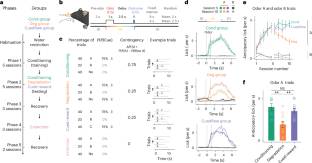
2025年3月18日出版的《自然—神经科学》杂志发表了美国科学家的一项最新研究成果。来自哈佛大学的Naoshige Uchida课题组报道了前瞻性偶然性解释了联想学习过程中的行为和多巴胺信号。
在本研究中,课题组检测了小鼠在巴甫洛夫偶然性退化任务中腹侧纹状体中多巴胺的活性——一个与联想学习有关的信号。研究小组发现,当额外奖励未被提示时,预期舔舐和多巴胺对条件刺激的反应都会下降,但如果有额外奖励提示,则保持不变。这些结果与偶然性的传统定义或新的因果学习模型(ANCCR)相冲突,但可以通过配备适当的间隔状态表示的时间差异(TD)学习模型来解释。在TD框架内训练的递归神经网络开发的状态表示类似于他们最好的“手工制作”模型。他们的发现表明,TD误差可以是描述偶然性和多巴胺能活动的一种测量方法。
据了解,联想学习依赖于偶然性,即刺激预测结果的程度。尽管它很重要,但将偶然性与行为联系起来的神经机制仍然是未知的。
附:英文原文
Title: Prospective contingency explains behavior and dopamine signals during associative learning
Author: Qian, Lechen, Burrell, Mark, Hennig, Jay A., Matias, Sara, Murthy, Venkatesh N., Gershman, Samuel J., Uchida, Naoshige
Issue&Volume: 2025-03-18
Abstract: Associative learning depends on contingency, the degree to which a stimulus predicts an outcome. Despite its importance, the neural mechanisms linking contingency to behavior remain elusive. In the present study, we examined the dopamine activity in the ventral striatum—a signal implicated in associative learning—in a Pavlovian contingency degradation task in mice. We show that both anticipatory licking and dopamine responses to a conditioned stimulus decreased when additional rewards were delivered uncued, but remained unchanged if additional rewards were cued. These results conflict with contingency-based accounts using a traditional definition of contingency or a new causal learning model (ANCCR), but can be explained by temporal difference (TD) learning models equipped with an appropriate intertrial interval state representation. Recurrent neural networks trained within a TD framework develop state representations akin to our best ‘handcrafted’ model. Our findings suggest that the TD error can be a measure that describes both contingency and dopaminergic activity.
DOI: 10.1038/s41593-025-01915-4
Source: https://www.nature.com/articles/s41593-025-01915-4
Nature Neuroscience:《自然—神经科学》,创刊于1998年。隶属于施普林格·自然出版集团,最新IF:28.771
官方网址:https://www.nature.com/neuro/
投稿链接:https://mts-nn.nature.com/cgi-bin/main.plex
